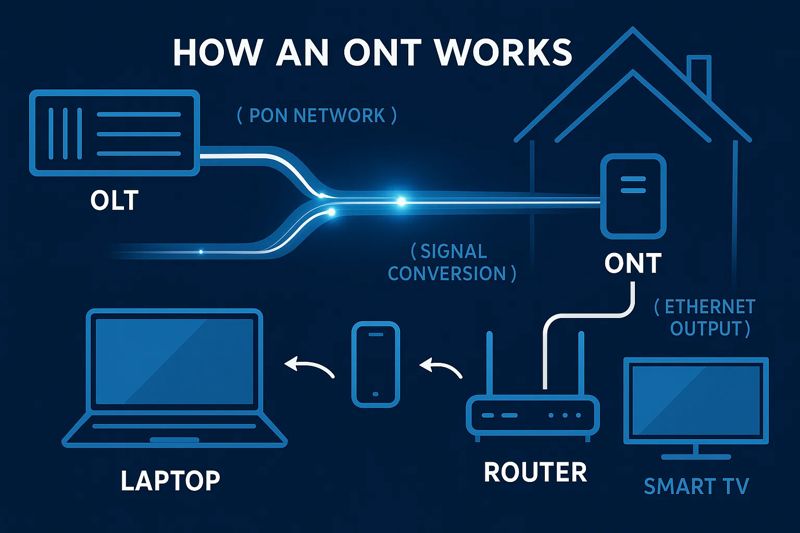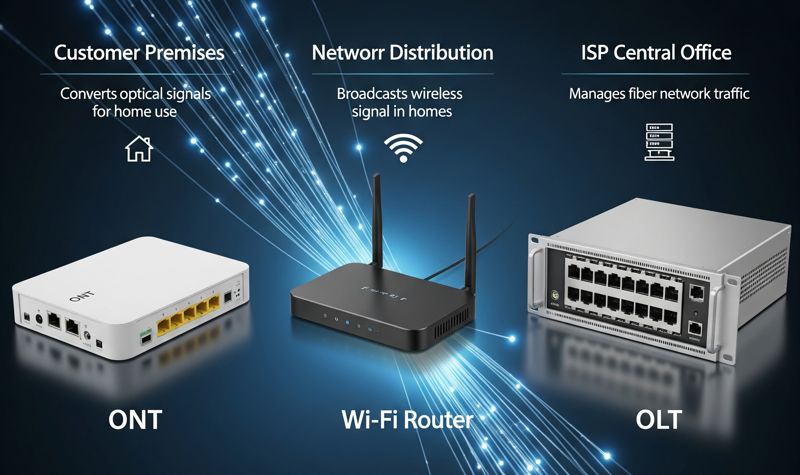Cable & Wire | High quality and excellent service at reasonable prices.
info@zion-communication.com
Author: James Publish Time: 12-08-2025 Origin: Site
With a growing need and increasing demand for fast and reliable internet, fiber optic cabling has become the embodiment of high data convergence. The very heart of every Fiber-to-the-Home (FTTH) or Fiber-to-the-Premises (FTTP) connection is the Optical Network Terminal (ONT). This small yet critical device converts optical signals into usable data for your home and/or business networks.
Whether you are a homeowner deploying fiber internet, service personnel from the IT industry, or a telecom provider, knowing the working principle of an ONT and its contribution to the network will enable you to effectively troubleshoot problems, meet performance demands, and achieve consistent internet service.

An Optical Network Terminal (ONT) is a device that serves in fiber optic networks for the purpose of converting the light signals that enter from the optical fiber to the electric signals which can be understood by devices such as routers, computers, or televisions designed for smart usage.
The device is typically located at the customer's premises, installed by an internet service provider (ISP). It connects to the Optical Line Terminal (OLT) at the provider's central office via the Passive Optical Network (PON).
Signal Conversion: Electromagnetic waves are converted from optical signals into electrical and vice versa.
Network Interface: Digital interface, including Ethernet ports and Wi-Fi.
Authentication: Provides access only to authorized users.
Power Management: Accessible device with the option of battery backup for power outages.
An ONT acts like the "bilingual" speaker for your ISP's fiber optics world and your home network:
Incoming Signal: The ISP employs data flow through the optical format as the pulse of light.
Signal Conversion: The ONT accomplishes this light beam conversion to electrical signals.
Data Distribution: Data is transferred by the ONT to your router through Ethernet-mapping the information to your devices.
Reverse Transmission: And about sends too, ONT converts electrical signals outputted from the device back into the light for transporting over the fiber line.
Feature / Device | ONT (Optical Network Terminal) | Modem | Router | OLT (Optical Line Terminal) |
Network Type | Fiber optic (FTTH, FTTP) | Cable, DSL, or other copper-based | Works with fiber, cable, DSL, or wireless | Fiber optic (PON networks) |
Location | Customer premises (end-user side) | Customer premises (end-user side) | Customer premises | ISP’s central office / data center |
Signal Conversion | Optical ↔ Electrical | Digital ↔ Analog or Electrical | No signal conversion (data routing only) | Electrical ↔ Optical |
Main Function | Connects fiber to user’s network | Connects ISP’s copper network to user | Distributes internet to multiple devices | Connects multiple ONTs to ISP’s backbone |
Internet Distribution | Needs a router for sharing | Needs a router for sharing | Provides Wi-Fi and wired LAN | Sends internet over fiber to multiple ONTs |
Required for Fiber? | Yes | No | Optional (but recommended) | Yes (core network side) |
Required for Cable/DSL? | No | Yes | Optional (but recommended) | No |
Ports Provided | Ethernet (and sometimes phone ports) | Ethernet (and sometimes phone ports) | Ethernet + Wi-Fi antennas | Fiber ports (GPON/EPON), Ethernet uplinks |
Managed By | ISP | ISP or end-user | End-user | ISP |
Example Use | Converts incoming fiber signal for home | Converts cable/DSL signal for home | Home/office network sharing | Distributes fiber connections to many users |

ONTs can vary depending on the setup and requirements:
Indoor ONT: Compact unit to be embedded within homes or offices.
Outdoor ONT: Technical waterproof unit attached to some outside area of a building.
Integrated ONT + Router: A hybrid device which combines the functionality of ONT and Wi-Fi router to a single unit.
Business-grade ONT: Holding up higher data volume and using multiple ports for enterprise category.
The ONT should be placed within the main router's sight so you can connect it using an Ethernet cable.
Use properly designed ventilation to avoid overcooling or overheating.
Don't put the ONT in a humid, dusty or hot area and you will be good.
If you used these batteries in a battery backup, check and replace them periodically.
For outdoor ONTs, make sure there is a sealing that is weather waterproof.
No Internet? Ask in the network - the source of power and indicator lights on PON/LOS.
Flashing LOS Light? It could signal the disconnection or no-business-hours service - the way to get the right information is to contact your provider.
Buffered download speed? Reboot the ONT or router, look for congesting traffic headings.
Dropouts all over the place? Check the fiber connector to see if it makes sense.
A: Yes, in most cases. The ONT provides the internet connection, while the router ensures it, using WLAN or Ethernet cable, then spreads the connection for all the connected devices.
A: Some carriers do, but many of them enable you to adopt their supplied ONT for their effectiveness and safety of the service traffic.
A: Yes. In case the ONT is turned off, then you will be disconnected to the internet. For critical services matters, consider the use of UPS.
A: The life expectancy of ONTs is around 5-10 years, although there are ISPs that replace them sooner if they want to support the latest technology.
A: No. The ONT is at the customer's premises; the OLT is located at the ISP's central office.
The Optical Network Terminal is your internet fiber connection. Understanding its functionalities as well as the primary maintenance procedures will ensure that your connection works to its fullest potential. You should not miss to learn the ONT connection process, its functions and how it can be helpful for the successful and steady connectivity.

James is a technical manager and associate at Zion Communication.
Specializes in Optical Fiber communications, FTTH Solutions,
Fiber optic cables, ADSS cable, and ODN networks.
james@zion-communication.com
+86 13777460328
